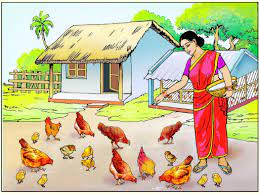Backyard Poultry Farming in Rural India
Backyard poultry rising is a historic activity in rural India that has been a vital part of rural lives for decades. It entails keeping a small number of poultry birds, such as chickens, ducks, or turkeys, on one’s own farm. This type of small-scale poultry farming serves several functions, including egg production, meat production, and money generation for rural households. Backyard poultry keeping provides an alternative source of income and sustenance for households in rural India, where agriculture is the major occupation. It is especially common in areas where land is plentiful but resources are few, making it an ideal source of income for rural people. Backyard poultry raising is firmly ingrained in rural India’s culture and traditions. It has various benefits, including protein-rich food self-sufficiency, the use of agricultural byproducts and kitchen trash, and the possibility to create cash from surplus production. Backyard poultry husbandry in rural India frequently entails raising indigenous poultry breeds that are well adapted to local climatic conditions and require little maintenance. These breeds are well-known for their hardiness, resistance to disease, and capacity to flourish on locally available feed supplies.
However, the practice is not without its challenges. Poultry diseases, predators, lack of access to veterinary services, and limited market opportunities can pose difficulties for rural poultry keepers. Nevertheless, with proper training, knowledge sharing, and support from government agencies, NGOs, and local communities, these challenges can be addressed effectively. In recent years, there has been a growing recognition of the importance of backyard poultry keeping in rural India. Various government initiatives and development programs have been introduced to promote sustainable and inclusive poultry farming practices. These initiatives aim to enhance the productivity and profitability of backyard poultry keeping while ensuring the well-being of the birds and the communities involved.
Reasons for keeping poultry:
Backyard poultry keeping serves various purposes for rural households. It provides a regular source of fresh eggs and meat for household consumption. Additionally, surplus eggs and birds can be sold in local markets, generating income. Poultry farming also helps in waste management as birds consume kitchen scraps and agricultural waste.
Breeds:
Several indigenous and local poultry breeds are well adapted to backyard poultry husbandry in rural India. These breeds are durable, disease-resistant, and low-maintenance since they are adapted to particular climatic circumstances. Kadaknath, Aseel, Giriraja, Gramapriya, and Vanaraja are popular indigenous breeds.
Housing:
Backyard poultry houses are typically small, simple structures made of locally available materials such as bamboo, thatch, or mud. The houses provide shelter from predators, extreme weather conditions, and ensure the birds’ safety. Adequate ventilation and proper lighting are essential for the birds’ health and well-being.
Feeding:
Poultry in rural backyard settings are often fed a combination of kitchen scraps, agricultural by-products, and locally available grains. The diet may be supplemented with commercial poultry feed to ensure balanced nutrition. It is important to provide clean water at all times and ensure a balanced diet to promote healthy growth and egg production.
Health care:
Maintaining good poultry health is crucial. Regular vaccinations, deworming, and periodic health check-ups are important preventive measures. Farmers can seek guidance from local veterinary professionals or government extension services for proper vaccination schedules and disease management practices.
Marketing and income generation:
Surplus eggs and birds can be sold in local markets or to neighboring communities. Establishing connections with local traders, hotels, and restaurants can help in marketing the produce. Additionally, rural households can participate in government-led poultry development programs that provide training, market linkages, and financial support.
Challenges and precautions:
Backyard poultry keeping in rural India may face challenges such as diseases, predation, and lack of access to veterinary care. Farmers should practice biosecurity measures to minimize the risk of diseases spreading. Proper sanitation, hygiene, and regular cleaning of the poultry houses are essential.
It is important to note that regulations and specific practices may vary across different states and regions in India. Local government agricultural departments and veterinary services can provide more detailed guidance on backyard poultry keeping in specific rural areas.
Backyard Poultry Farming in Rural India




